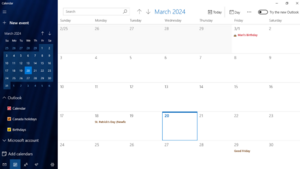Calendar (Windows)
 Calendar running on Windows 10, using the light theme | |
| Developer(s) | Microsoft |
|---|---|
| Initial release | 24 November 2014 |
| Stable release | 16005.14326.22178.0
/ 24 January 2025[1] |
| Operating system | Microsoft Windows |
| Predecessor | Windows Live Mail |
| Successor | Microsoft Outlook |
| Type | electronic calendar |
Calendar is a personal calendar application made by Microsoft for Microsoft Windows. It offers synchronization of calendars using Microsoft Exchange Server, Outlook.com, Apple's iCloud calendar service, and Google Calendar. It supports the popular iCalendar 2.0 format.
History
[edit]Microsoft first included a Calendar application (shortened to app) in Windows 1.0, which was included through Windows 3.1, and was replaced by Schedule+ in Windows for Workgroups and Windows NT 3.1. Schedule+ was later moved from Windows to the Microsoft Office suite,[2] and Windows did not include another Calendar application until Windows Calendar in Windows Vista. Calendar had been created by Beta 2 of Windows Vista.[3]
Windows Vista
[edit]This version supports sharing, subscribing, and publishing of calendars on WebDAV-enabled web servers and network shares. It has always supported .ics files, and the subscription feature enables syncing with Google Calendar.[4] Its interface matches Windows Vista Mail's, but the two apps are not connected in this operating system. The default calendar can be renamed.
On the calendar taskbar applet, there is a date grid on the left side and a skeuomorphistic analogue clock and a digital clock underneath on the right side. Additional clocks displaying different time zones can be added to the view. On the date grid (left side), dates far in the past or future can be looked up by zooming out by clicking on the date range indicator above the calendar grid, until each tile is a decade (e.g. 2010-2019, 2020-2029).[5]
This version has later been inherited on Windows 7.[5]
Windows 8
[edit]A new version of Calendar with a text-heavy was added to Windows 8 as one of many apps written to run full-screen or snapped as part of Microsoft's Metro design language philosophy. It is one of three apps on Windows that originate from Microsoft Outlook, the other two being Mail and People apps. Structurally, the three apps are one and are installed and uninstalled as such. But each has its own user interface. Calendar in Windows 8 originally supported Outlook.com, Exchange, Google Calendar, and Facebook calendars. Because of API changes, Facebook and Google calendars can no longer be directly synced on Windows 8.[6] Like many Microsoft apps introduced for Windows 8, many of the features are hidden in the charms or a menu at the bottom of the screen that is triggered by right clicking. Different calendars can be labeled with different colors. When a user with a Microsoft account adds a calendar account on one computer with Windows 8 Calendar, the account will be automatically added to all other Windows 8 computers the user is logged into. .ics files are not supported in this version.
Windows 10
[edit]Calendar has preset server configurations for Outlook.com, Exchange, Google Calendar, and iCloud Calendar.[7][8][9] Users can set it to use the system theme or choose a custom accent color, background image, and light/dark preference. Windows 10 Calendar has multi-window support for viewing and editing events. Different calendars can be labeled with different colors, and events can be rearranged by dragging and dropping. The default interface is Month View, but users can also use Day, Week, and Year views and print these views. The Windows 10 app also uses a flyout settings panel and a mini Ribbon interface in the viewing pane. The day of the year and calendar events show on the live tile. Like the Vista version, the important controls are readily visible and use icons to match the system's. Accounts can be grouped and relabeled, but folders cannot be edited from within the app. .ics support was added to this version in time for the Windows 10 Anniversary Update.[10]
See also
[edit]- Features new to Windows Vista
- Features new to Windows 8
- Features new to Windows 10
- SyncML open standard for calendar syncing
References
[edit]- ^ "Mail and Calendar". Microsoft Apps. Retrieved January 27, 2025.
- ^ Mefford, Michael (March 12, 1996). "An appointment Calendar for Windows 95". PC Magazine. Vol. 15, no. 5. Ziff Davis. p. 269. ISSN 0888-8507.
- ^ Clyman, John (June 8, 2006). "Windows Vista Beta 2". PC Magazine. Ziff Davis. Archived from the original on September 19, 2016. Retrieved August 25, 2017.
- ^ Heddings, Lowell (January 2, 2007). "Display your Google Calendar in Windows Calendar". How-To Geek. Archived from the original on November 4, 2021. Retrieved July 27, 2016.
- ^ a b Pash, Adam (June 16, 2009). "Quickly Navigate Your Calendar to Find the Day of any Given Date". Lifehacker. Archived from the original on June 19, 2009.
- ^ "Calendar app help". Support. Microsoft. April 28, 2016.
- ^ "Set up email in Mail for Windows 10". Office.com. Microsoft. Retrieved July 13, 2016.
- ^ Casey, Henry T. (February 10, 2016). "How to Set Up iCloud Email and Calendars on Windows 10". LAPTOP.
- ^ "A closer look at the new Mail app on Windows 10". MSPoweruser. April 7, 2015.
- ^ "What's new in Mail and Calendar for Windows 10". Office.com. Microsoft.
Further reading
[edit]- "Set up email and calendar". Support. Microsoft. July 29, 2016.
